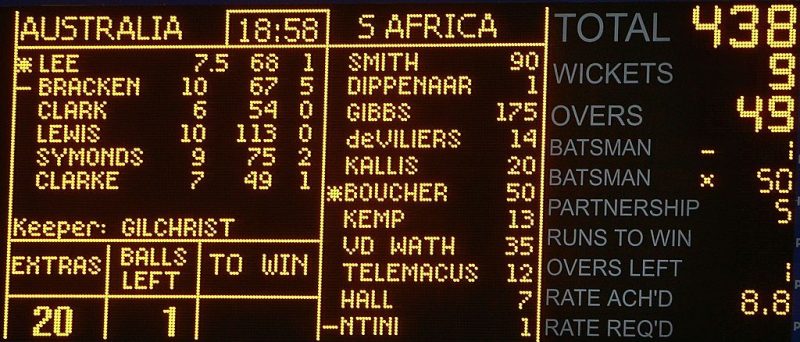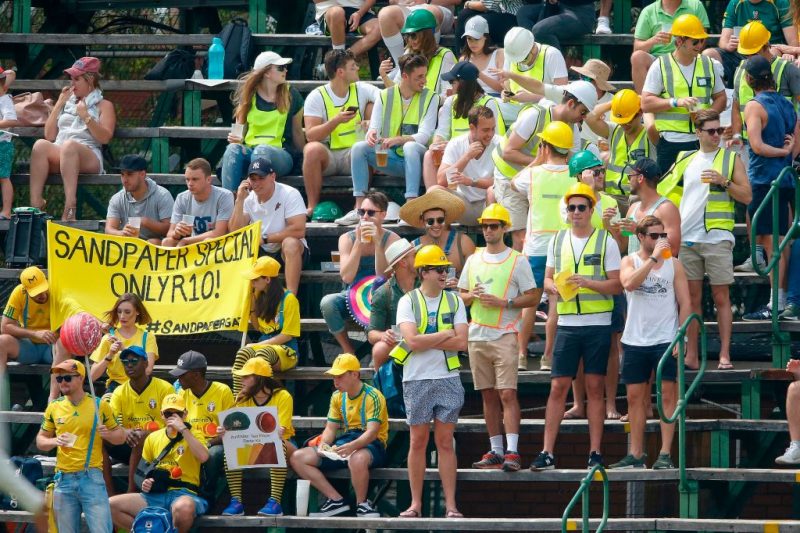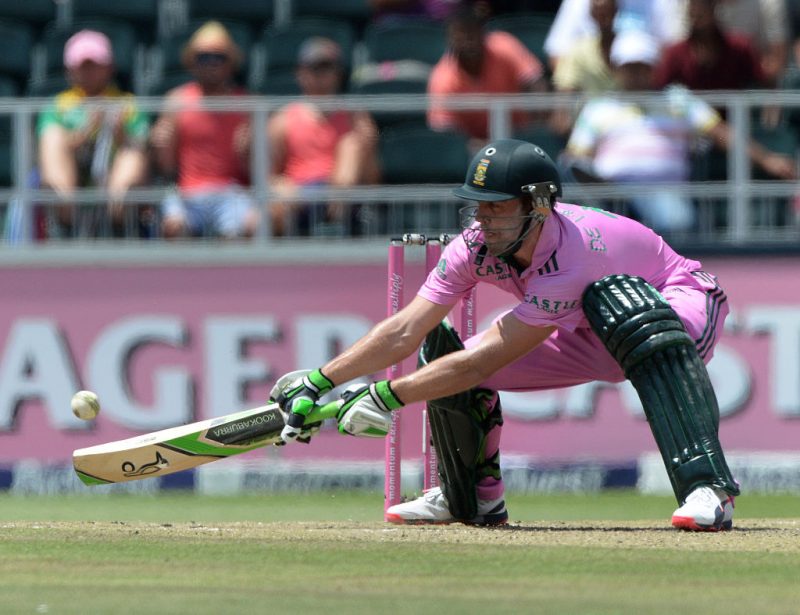
The pitch sizzles as if made of cast iron, eager for a slab of fresh meat in the form of a visiting batsman not yet acclimatised to the scorching heat.
I didn’t understand any of this the first time I attended a match at South African cricket’s spiritual home. It was early 1997. I was eight years old; all floppy hat and sunblock as I slogged up the ceaseless slope that is Corlette Drive in Johannesburg’s leafy northern suburbs. Like all children first introduced to a religion that would one day shape their adult lives, it was my parents who brought me to worship.
First published in The Nightwatchman, Daniel Gallan paints a personal picture of The Wanderers, the spiritual home of South African cricket.
The outfield shimmers. The pristine carpet of green is a still lake. A solid forward defensive is enough to see the ball skim across its surface like a water-striding insect, barely breaking the tension underfoot.
The stands are a heaving, swirling mass. The noise rises and falls like a Highveld summer storm. Lightning, thunder, deluge; a cacophony of colour and sound.
This is the Bull Ring. Not merely a cricket stadium but an ode to the elements. A cathedral that pays homage to the full fury of nature’s brilliance. All that is thrilling about this meandering sport is condensed here. This ground has grown up in the City of Gold and now embodies the impatience of its people, never missing a chance to hit the fast-forward button on a stagnant day’s play. No other venue in the world can match the firepower of a breathless showstopper at the Wanderers.
***
I liked cricket. I’d been playing it for the three years since my nose was set permanently askew from the first delivery I took guard against, but the thought of enduring an entire Sunday cooped up in one place watching others play was not my idea of a good time.
But I didn’t complain. The stadium had already shown me a kindness and so I compelled my tiring legs to complete their trudge as a way of giving thanks.
Earlier in the week, ahead of the first Test against the visiting Australians, my mother had taken me along to a training session to catch a glimpse of the boogymen of world cricket. There they were. Shane Warne. Steve Waugh. Glenn McGrath. None of them acquiesced to my nagging requests for an autograph.
But I was a son of the soil and The Wanderers would not let those nasal-toned bastards from across the Indian Ocean treat me with disdain. The mighty arena hailed a bolt of lightning from the heavens and sent it screaming into the field’s metal perimeter fence. That sent those smug Aussies hopping away like startled kangaroos and stitched a smile across my face.
On game day I skipped up the final few metres of the hill, funnelled in with the stream of bodies, passed through the turnstiles and entered a world that assaulted my senses. In every direction were the rainbow colours of South Africa. The triumphs of the Rugby World Cup in ’95 and the African Cup of Nations in ’96 had conditioned me to associate the greens, yellows, reds and blues of my nation with sporting triumph. (This ground – indeed, this sport – would put this ignorant assumption to bed soon enough.)
 Perhaps the greatest ODI ever played took place at The Wanderers
Perhaps the greatest ODI ever played took place at The Wanderers
After the sights came the smells. To the left, the bubbling vats of oil that crisped a barracks’ worth of hamburgers, fries and mini doughnuts. To the right, the buttery smell of spilled beer from the bar Somewhere in the distance, charcoal and wood burned in preparation of a braai.
I don’t remember a single ball from that match. I don’t remember McGrath reducing South Africa to 32 for 3 before a pair of 70s from Hansie Cronje and Dave Richardson dragged the side to a respectable 302 all out. I don’t remember Steve Waugh’s 160 or Greg Blewett’s 214 (still the highest Test score at the ground). I don’t remember Warne and Michael Bevan grabbing four wickets apiece to win the match by an innings and 196 runs. All I remember is that I laid down an identity foundation block on the grass embankment in one corner of the Bull Ring.
Looking at the embankment now, it doesn’t seem like much. But there was a time for me when the grass was the epicentre of The Wanderers. Ball games are still permitted within the family area and none of the action out in the middle could ever match the intensity of the countless matches I took part in. An aerial shot of this teeming swarm of pre-pubescent mayhem could have been mistaken for a Hieronymus Bosch painting.
I learned the craft of batting with soft hands during those duels on the slope. A strong-armed stroke could send the ball careening into the side of a spectator’s head or onto the field, which would invariably lead to Mom or Dad putting an end to my day’s play. However, I also had to bat with a sense of authority. One’s reputation was at stake on the embankment and there were always eyes watching your technique as well as older children to impress.
When I was (eventually) dismissed, or my parents insisted I eat, my gaze would drift out to the middle but barely make it past the boundary fence. Somewhere near the rope, close to the embankment, there would be a fielder stationed at fine leg or third man and, one way or another, that fielder was signing my mini bat. Once, when a stocky Yorkshireman with a talent for moving the ball through the air refused to oblige, the entire embankment rose up with chants of “Sign his bat! Sign his bat!” The Wanderers faithful have always taken care of their own.
On the grass I learned that cricket is meant to be enjoyed. I learned how trivial it all is. I learned that it’s a child’s pastime as much as it is a lightning rod for national pride. I learned that the pursuit of some unknown twelfth man’s autograph could mean more to a little boy than the result of a Test.
 The crowds don’t give players an easy time at The Wanderers
The crowds don’t give players an easy time at The Wanderers
Eventually, I became more interested in the ball in the middle rather than those I had brought with me and, sensing the shift, my parents introduced me to my second corner of the Bull Ring.
From behind the bowler’s arm, as he steamed in from the Corlette Drive End, I learned to appreciate the subtle beauty of cricket from the Unity Stand. My transition from grass to plastic bucket-seat felt like a coming of age. It signalled that I was there to participate as an adult. I’d oooh and aaah along with my parents and the rest of the crowd even if I didn’t always know why. I understood the significance of wickets and sixes but the importance of a play-and-miss or a well-worked single was beyond me.
Rather than accept my ignorance, I asked an endless stream of questions. Why was that a good bouncer? How come there is no one at cover? Why is that spinner too good for our batters?
If my parents didn’t know the answer I’d make a mental note and bring the query to my coaches. And as captain of my school team I’d experiment with field changes that I’d seen Graeme Smith or Neil McKenzie implement.
In the Unity Stand I grew to love the game for what it is; a million individual moments that make up something grand. Of course there were times when loving the game was easy: Allan Donald’s devastating six-for against England in 1999; Lance Klusener’s match-winning knock in an ODI against Australia in 2000 that (somewhat) made up for the heartache of the previous World Cup; Brian Lara’s sublime 202 in 2003.
It is a privilege to be able to write about this sport for a living. This is not just a hobby but how I pay the bills. None of this would be possible without some knowledge of the game and my education would be incomplete, non-existent even, without the Bull Ring.
My next corner of the ground came by default. In truth it was the only corner available to me and my ilk. Now in university and with a taste for beer, I found myself in an ocean of short shorts, sleeveless shirts, straw hats, flip-flops and exposed skin on the Wooden Benches of the Open East Stand.
In a country with tighter health-and-safety standards, those decaying planks and their protruding iron bolts would have been burned long before me and my mates ever called it our corner of the Bull Ring. The climb to the top of the benches is steep and its seating is splintered and uncomfortable. There is no respite from the searing sun. There really is only one way to enjoy yourself and that is to get day-drunk and rowdy.
A common tactic was to turn an entire watermelon into a vodka receptacle and drink its slushed contents by lunch. Another was to forgo whatever money you were going to spend on food and bank on the theory that beer is liquid bread. Maybe a friend will arrive with a bag of biltong. Secretly, you hope he’s bringing more beer.
Life’s hard on the benches and the people are harder. Ask any Englishman or Australian who has had the misfortune of fielding down at fine leg during the afternoon session on a Saturday.
I hurled abuse with the rest of them. There’s safety in numbers and it was our patriotic duty to do so. I sang till my throat was raw.
I’m not proud of my behaviour. Not all of it anyway. At the time I failed to see the irony of screaming obscenities at 6ft 3 chiselled athletes who were out there living my dream. I see it now and haven’t repeated the behaviour since my voice cracked in the middle of letting Stuart Broad know what I thought of his haircut in 2010. When he skulled 6 for 17 in 2016, I felt I was partly responsible.
There are no half measures on the benches. I saw the opening game of the inaugural T20 World Cup there, the one where Chris Gayle bludgeoned the format’s first international century in a losing cause. I sat slack-jawed as AB de Villiers defied logic with an eye-watering 149 from 44 deliveries in 2015. No one has ever, or will ever, hit a cricket ball so sweetly for so long as Mr 360 did that day.
 AB de Villiers put on a show at The Wanderers in 2015
AB de Villiers put on a show at The Wanderers in 2015
I wasn’t there on the most famous of occasions. When Mark Boucher hit the winning runs in 2006 to secure victory in the ‘438’ game I was glued to a TV, ignoring the festivities of my cousin’s engagement party around me. Even on a two-dimensional screen I could tell it was the Bull Ring. If you edited out the stands and the crowds, if you de-saturated all the colour from the player’s clothes, still there could be no mistaking where this record-breaking fixture was taking place. Where else does the ball crack into the keeper’s gloves with such ferocity? Where else does the ball slice through the thin altitude air with such ease? Where else do inside-out cover drives, short-arm jabs through the on side or cute paddles over fine leg sail effortlessly into the stands?
Newlands has its views of Table Mountain, Lord’s its history, the MCG its grandeur and Eden Gardens its fanaticism; but The Wanderers trumps them all when it comes to putting on a show. All those other famous grounds require context to be considered great. The Bull Ring doesn’t need context.
In late 2018 my love would be requited. I had always dreamed of earning a living in cricket but my slow feet and hands had proved my undoing. But The Wanderers is kind. The Wanderers is giving. The Wanderers welcomed me into its fold high up in the press box and offered views of the majestic stadium in all its glory.
From here I saw Aiden Markram come of age with 152 near-perfect runs against an Australian side still reeling from the ball-tampering scandal a week earlier. I saw Vernon Philander bag 6 for 21 in a mesmerising spell in that same match to win a series against the old enemy on home soil for the first time as a united nation. I saw Dean Elgar and Hashim Amla stand their ground like doomed Spartans on a treacherous pitch against Viral Kohli’s India.
I’ve only just settled into this new corner of the Bull Ring. I no longer carry a mini bat in search of signatures. I no longer ask why the crowd is applauding. I no longer have a cold beer close at hand at all times. Now I’m hacking away at my keys, satisfying a demanding editor and jostling for column inches and bandwidth attention. Now I’m serious, at least on the outside.
Inside I’ll always be that barefooted boy on the grass, that curious adolescent in the Unity Stand, that rowdy fan on the benches. I may have climbed as high as I can at the Bull Ring but I’ll never forget what the stadium has given me.
This article first appeared in issue 28 of The Nightwatchman, Wisden‘s cricket quarterly. Buy it here.








